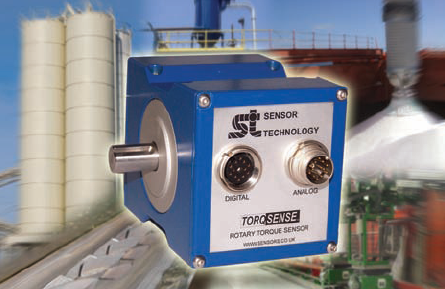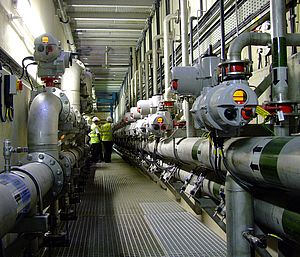Say ‘process control’ and most people automatically think of monster-sized central computers running barely-fathomable SCADA software in a control room that would not be out of place at Cape Canaveral. But out on the plant floor, there may be literally thousands of simple sensors and switches, collecting data and feeding it back to the Beamoth.
These sensors are tracking every little change in the plant’s operating parameters, indicative of either the state of the materials being worked or of the state of the machinery itself. For instance an increase in torque on a mixer drive may suggest that a mixture within is thicken up as expected, or alternatively that a seal or bearing is sticking and may soon fail altogether: either way this is vital information for the central computer to capture and assess.
Ultimately, process engineers want to transform material from one state to another, and to monitor variables indicative of the various stages of the process. Some parameters can be measured directly and simple – temperature for example. Others are more difficult to measure, so an often-used technique is to measure a related parameter (typically one related to the plant or machinery rather then the process material) and interpolate from this.
Significantly many types of process plant – mixers, pumps, conveyors - are motor driven, and measuring the motor output characteristics will often provide process information. For instance, the torque of the motor could suggest the quantity, speed or viscosity of the process material being worked. Obviously, measuring the processing is the primary concern of the production engineers, but torque measurement has a second, equally important function. Because you are actually measuring plant performance, you get to see how the machinery is holding up. Knowing what to look for will give you early warning of breakdowns, allowing you to schedule pre-emptive maintenance. For a continuous process where downtime can cost thousands of Euros an hour in lost production, this can be critical - ultimately the difference between healthy profit and catastrophic loss.
This all sound very useful, and actually measuring torque can be very simple. Not so long ago torque sensors required a fairly complicated and fragile array of slip rings connected to the rotating drive shaft of the machine under test. TorqSense provides a noncontact means for taking the readings. In use, a couple of simple pads are glued to the side of the driveshaft and a TorqSense unit mounted close by. The device then starts monitoring torque, and feeding it as a data signal to the SCADA control system.
Principles
The pads are in fact tiny little piezoelectric combs encased in plastic. The combs are designed to open or close under the torque effect of their rotational speed on the drive shaft. The greater the torque, the more the distortion.
The TorqSense unit emits a low powered radio frequency signal towards the combs, which reflect it back. The reflected signal comes back at a changed frequency, the change being proportional to the distortion of the combs, and thus to the torque in the drive shaft.
The physical phenomenon which deforms the combs is called the Surface Affect Wave (SAW), a property first noted in 1885 by gentleman-scientist Lord John William Strutt Rayleigh. He postulated many possible used for SAWs, but was unable to realise practical use for any of his theories. It was not until the 1920s that they were shown to be generated by the moving edges of earthquakes and avalanches, the recording of which using low frequency vibration monitors formed the basis of modern seismology and volcanology.
By mid century scientists were creating SAWs in laboratories and developing new ideas for their use. As the century closed Sensor Technology Ltd were using the phenomenon to develop a new method of torque monitoring, the non-contact nature of which promised to be very attractive to working engineers.
Testing pumps
Charles Austen Pumps (CAP) has recently upgraded its test facilities with Surface Acoustic Wave (SAW) equipment from Sensor Technology. Charles Austen Pumps manufactures pumps individually designed to meet specific customer requirements that cannot be satisfied by off-the-shelf units. Much of its work comes down to optimising drive dynamics to produce the desired characteristics, be it a smooth flow in a critical medical situation, ultra low noise for pumps in home and office installations, or the guaranteed extra long life of pump in inaccessible locations.
The cyclic nature typical in many pumps’ operation tends to induce torsional oscillations in the drive shaft, which can have a significant adverse effect on performance if unchecked. CAP has recently built a new test station based on Sensor Technology’s SAW sensors, and it is proving it’s worth time and time again. Advantages of SAW techniques include a broader signal bandwidth than other analogue based technologies and elimination of electronic interference. As CAP found, it often also proves far lower cost, simpler to use, is more reliable and has a wider operating range than contact alternatives.
Currying flavour
Real time process control for food manufacture involves characterising the flow and mixability of highly non-Newtonian fluids. TorqSense transducers monitoring the constantly changing flow characteristics of materials as diverse as tomato ketchup, chocolate, pasta sauce and chicken tikka massala as they are mixed.
Many manufactured food is presented in a sauce or as what physicists could describe as a neo-liquid and can be produced in a process-type environment. But to date real time control has been virtually impossible due to the non-uniform nature of the food, which may contain particulates, fibres, vegetables, meat, nuts, raisins, biscuits etc.
To achieve real time control the TorqSense has to be able to detect the changes with sufficient sensitivity, yet be robust enough for regular washdowns and general industrial abuse. Of course it must not compromise hygiene standards and regimes either. The device has been found to meet all these requirements and is being used in by a number of food processors.
Often the key requirement is to mix sufficiently to achieve a uniform dish, but not to waste time and energy by over-mixing. This can be done by monitoring the torque on the mixer’s shaft, as it will move to a steady state (within the characteristics of the given recipe) once fluid uniformity is achieved.
Mixing
A TorqSense is helping analyse recipes’ mixing properties in a project that could slash development costs in the food and plastics industry and help nanotechnology advance in the pharmaceuticals world.
Research and development is being carried out at the University of Bradford to develop a miniature mixer (5-25 grams batch) that incorporates a set of integral instruments to monitor the properties of materials as they are being mixed. The instruments work in real time during the mixing process and their output is captured to a PC for analysis. Software is being written so that the analysis can be performed simultaneously with the mixing and perhaps even used to interactively control the mixer itself.
One of the key parameters to be measured is the torque of the mixing element, as this will become constant once mixing is complete. This is measured by a TorqSense non-contact sensor that offers the development team the great advantage of not requiring complex and delicate slip rings, making the mixer easier to build (and rebuild between trials) and far more robust in operation.
The Mini Mixer development and validation is the result of a three year EPSRC sponsored programme of research. The results of this research are expected to have a major impact on formulation of viscous mixes and scale-up of extruders. Traditionally recipes for formulating say specific coloured plastics for consumer products are developed in 25 to 50kg batches, mixed in an industrial scale twin screw compounder. Several batches may be required before the recipe is finalised, so the cost and time involved can be considerable.
Clearly the development of a smaller mixer is advantageous, but the laboratory device must be able to duplicate mixing in the larger scale and guide design and operation of large machines and that is what the research programme has achieved. The fact that the technology will transfer to the plastic industry and other soft solid sectors means it is likely to rapidly recoup development costs.
Torqing Sense for Process Plant Control
Plant monitoring and control is particularly vital in the continuous process industries, where multiple machines must act in harmony day after day.
- by Sensor Technology Ltd
- May 14, 2009
- 201 views


















